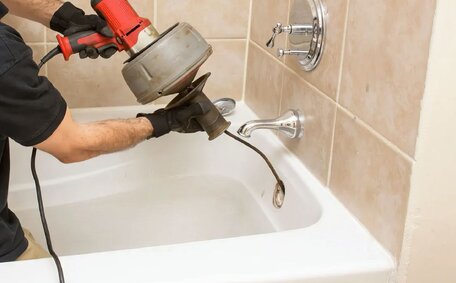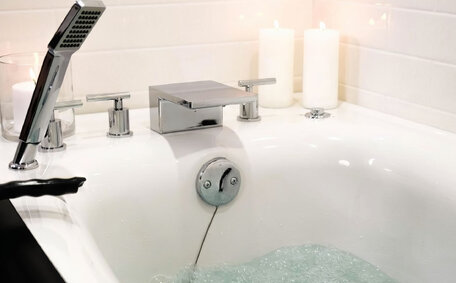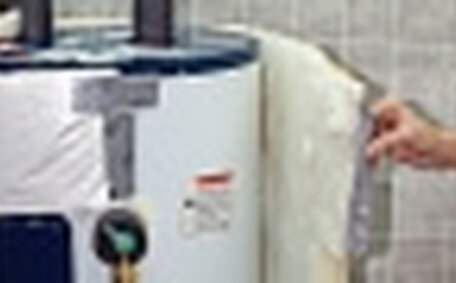What causes low hot water pressure?
Several factors contribute to low hot water pressure in homes:
- Sediment buildup in hot water cylinder, pipes, and heaters over time which restricts water flow
- A partially closed shutoff valve may restrict flow, potentially creating uneven water pressure.
- Faulty pressure regulators commonly cause diminished hot water pressure.
- Malfunctioning parts such as flow sensors, essential for regulating pressure, or defective relief valves
- Inadequate water supply lines and plumbing fixtures impeding water flow
Alleviating sediment buildup and adjusting pipe pressure can bolster flow and dependability in your hot water system. Seeking a professional plumber’s advice is recommended to effectively diagnose and solve low hot water pressure issues.
Checking for pipe blockages and clearing sediment
Here are some steps homeowners can take to check for pipe blockages and clear out sediment in their hot water systems:
Inspecting Water Pipes and Fixtures
Undertake a thorough examination of all accessible pipes, involving hot water lines, cold water tank connections, main lines, joints, valves, and fixtures around your residence. Look for any signs of corrosion, leakages, or mineral deposits which could be hindering your cold water pressure and indicate a potential blockage. Pay particular attention to sections with many bends connected to water heaters, boilers and temperature/pressure relief valves.
Checking Water Flow
Turn on multiple taps progressively from nearest to the water heater to the furthest to evaluate hot water supply. Check if the water flow remains consistent at each tap or weakens with distance, which could indicate sediment buildup within the pipes.
Flushing The Hot Water System
Sometimes de-scaling or a complete system flush performed by a plumber is necessary to clear stubborn sediment and rejuvenate your tank system.
Connect a hose to the water lines and open the drain valve to flush out sediment. For tankless heaters, ensure you switch off your unit as directed before attempting any maintenance on the heat exchanger. To effectively maintain your hot water heater while it’s being used, locate the drain valve at the bottom for sediment removal from the water pipe.
Regular checks of valves, plumbing lines, and heater flushes, as well as water meter monitoring, can prevent build-up and efficiently manage low water pressure. But if flow issues persist, it’s best to call professional plumber for inspection and clearing services.
Inspecting water heater components
Regular inspections of crucial water heater components ensure they function and shut off correctly, maintaining mains pressure in your water system.
Checking The Pressure Relief Valve
Locate the pressure relief valve near the top of your water heater tank. Ensure a careful visual check for leaks or corrosion.
Manually triggering the valve by lifting or turning its handle should confirm the valve allows unobstructed discharge, vital for optimal water flow. Replace it if water does not flow, there is visible damage or it is more than 5 years old.
Inspecting The Thermostatic Mixing Valve
Ensure the tempering valve is operational, crucial for maintaining even cold and hot water temperatures. This helps prevent scalding by regulating hot cold water to a safe water temperature. Inspect the valve for leaks or visible damage. Refer to manufacturer guidelines for testing water temperatures and replacing faulty valves when needed.
Replacing Heating Elements
Internal heating elements in gas and electric water heating systems help maintain consistent water pressure by efficiently warming the water. This can restore pressure and heating performance.
Over time, build-up on heating elements can decrease their efficiency and reduce your hot water pressure. Consult a qualified Marrickville plumber to check elements and replace them if worn out or heavily scaled.
Proactive maintenance of valves and heating elements can heighten system efficiency and prevent pressure loss. Contact the experts at Marrickville Plumbing if you need assistance servicing your hot water system.
Upgrading fixtures and fittings
Upgrading plumbing fixtures like taps, showerheads and other fittings can help optimise water flow and increase hot water pressure in your homes.
Installing High Flow Showerheads
Modern water-efficient showerheads can provide a satisfying shower with less flow, around 7 litres per minute, in contrast to older models that restrict flow to about 9 litres per minute. Installing a higher flowing showerhead can increase water pressure in your shower.
Choose showerheads with self-cleaning nozzles and adjustable flow featuring durable parts that maintain stable hot water pressure and prevent restrictive limescale build-up. Choose designs durable enough to handle varying water pressures, which in areas like Marrickville, typically range between 35 to 50 PSI.
Replacing Tap Aerators
Older sink and basin taps often contribute to poor hot water pressure with low flow aerators installed to conserve water. Replacing these aerators with less restrictive versions can allow more water flow at the same mains pressure level.
Consult with manufacturers to choose aerators designed to strengthen water flow while ensuring optimal performance. Consider features like multi-flow options to control water usage.
Upgrading To Commercial Grade Fittings
In commercial settings like office buildings, hotels and public amenities where water demand is high, upgrading to commercial grade taps, valves and pressure-balanced mixers builds in extra flow capacity to maintain hot water pressure even at peak usage.
A licenced plumber can guide how increase and sustain the water pressure your commercial systems require during renovations or new constructions.
Installing fixtures designed for optimal hot water flow for your particular application ensures you experience good water pressure without requiring extensive plumbing work to increase supply system capacity.
Installing circulation pumps and pressure boosters
Having a pump installed, such as a hot water booster pump or a circulation pump, can offer a long-lasting remedy for hot water pressure challenges in homes without a gravity-fed system.
Hot Water Recirculation Pumps
Recirculation pumps continually move hot water, maintaining pressure throughout the system by channeling water through a designated return line. This removes the wait for hot water to reach taps, ensuring faster access. Hot water from the main water supply is immediately available at taps nearest to the pump, enhancing user comfort.
Booster pumps suitable for home hot water pipes are affordably priced, not including the cost for professional return line installation. Operating costs for a booster pump are low and most models last for over 5 years.
Water Pressure Booster Systems
This is an effective option when water supply pressure to your property is inadequate, often below 40 PSI. A water booster pump uses an electric mechanism to augment the incoming pressure within your plumbing infrastructure.
Pressure boosters can markedly increase water flow and provide an instant boost in pressure compared to gravity fed systems. Professional supply and installation averages $2000+ but results in strong, consistent hot water pressure through all fixtures.
Selecting pump circulation or high-pressure booster installations requires professional plumbing expertise for optimal integration with your existing system. Consult our team at Marrickville Plumbing to determine the most suitable and cost-effective solution for boosting hot water pressure in your house.
Fixing issues in gravity-fed systems
A gravity fed system for hot water relies on the weight and flow of water through pipes as opposed to pumps to supply pressure. Over time, issues like sediment buildup and undersized components in your pipes can severely reduce flow and pressure.
Installing Circulation Pumps
Adding a circulation pump creates a continuous supply loop, pushing water around to provide instant hot water with improved pressure. Retrofitting existing piping is complex but results in excellent pressure.
Replacing With Mains Pressure Units
Transitioning to a mains pressure system includes installing a tank coupled with an electric pump to enhance pressure. Optimising your water storage tank setup tackles pressure worries but may necessitate comprehensive and possibly more expensive plumbing modifications.
Increasing Pipe Sizes
Upsizing to larger-diameter pipes can increase water flow and improve pressure in your hot water system. Combined with pipe descaling, this addresses fundamental problems to optimize performance.
The experts at Marrickville Plumbing can survey your home’s existing system, identify causes of low pressure and recommend the most practical and cost-effective solution whether adding pumps, replacing components or increasing pipe sizes.
Dealing with hard water buildup
Hard water can lead to limescale accumulation in hot water cylinders, gradually impacting appliance performance. This can cause a restriction in water flow and a decrease in hot water pressure.
Signs of Hard Water Buildup
Some clear signs of hard water buildup in your hot water system include:
- Diminished flow from hot taps is a telltale sign of diminished water pressure in your plumbing.
- Noisy rumbling or banging from pipes
- White/yellow mineral staining on tubs and sinks
- Musty smell from hot water
Mitigating Hard Water Issues
To reduce the impacts of hard water and increase hot water pressure:
- Install water filters or softening systems to eliminate minerals
- Frequently flush heaters and pipes to clear deposits
- Upgrade to scale-resistant plumbing fittings
- Employ pipe insulation to prevent scale buildup
- Switching from galvanised steel pipes to PEX or copper can mitigate hard water effects
In areas with prevalent sediment scale, such as the Gold Coast, proactive measures are essential to maintain optimal hot water pressure and flow.






